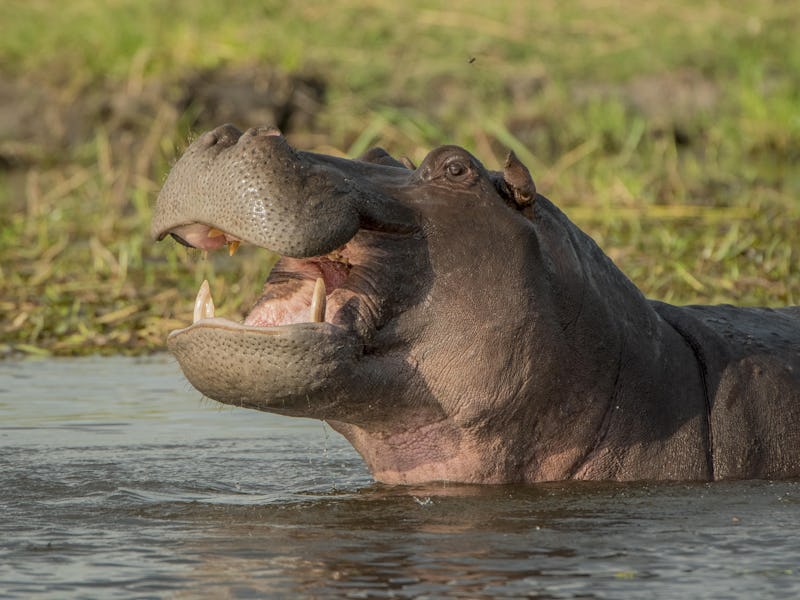Drones can research hippos better than humans
Hippos and drones, together at last.

Despite their threatened status, the fact that hippos are nocturnal, amphibious and just plain aggressive has made it very difficult for scientists to actually study them. So to solve this problem scientists had to get creative. They found that using low-cost drones to observe the hippos not only made studying them easier but provided more accurate data as well.
Native to sub-Saharan Africa, these semiaquatic mammals are now threatened by habitat loss as well as hunting and ivory poaching. And while world populations are believed to be between 115,000 to 130,000, scientists say that collecting accurate population and age data about these animals is actually incredibly tricky.
“Even though hippos are a charismatic megafauna, they are surprisingly understudied, because of how difficult it is to work with nocturnal, amphibious and aggressive animals,” said lead author and Ph.D. candidate at UNSW Science, Victoria Inman, said in a statement.
The DJI Phantom 4 drone
Traditional observation approaches either use high-speed, aerial cameras, or more hazardous water and land surveys. While land surveys have proven to be the most beneficial of the three so far, they are also more challenging thanks to the remote location of some hippo pods as well as the potential danger posed to researchers should a hippo respond aggressively.
In the study, published this month in the journal PLOS ONE, scientists explore how using low-cost drones may improve not only the safety of such observations but the quality of data collected as well. The study was conducted at a lagoon in Botswana over a seven-day period in 2017 and used a DJI Phantom 4 drone to capture aerial footage of the hippos.
To determine what height might be best for these observations, the researchers took footage at 120 meters (394 feet), 80 meters (262 feet), and 40 meters (131 feet) above the ground during different points of the day. In total, they completed 84 drone trials.
Footage from the team's aerial drone cameras.
While traditional aerial surveys are also flown around this same height (usually around 100 meters, or 328 feet) they go much faster and not only compromise data as a result but can also disturb hippos. Scientists were happy to see that the drones, on the other hand, barely disturbed the hippos at all.
After comparing footage from the different drone runs the team was able to determine that drones flown at 40 meters were not only the best among the other trials but were also 10 percent more accurate than traditional land surveys. Footage from these 40-meter trials helped scientists more accurately count the number of individuals in a hippo pod as well as better estimate the age of individuals based on observed length measurements of the animals.
The better quality data collected from these 40-meter drone runs also helped scientists dispel a long-held assumption about hippo observation. Scientists used to believe that observing hippos during the early morning was the best time to collect accurate population data, but these trials found that the early morning might actually be the worst time to observe them.
“Interestingly, we found that early morning was the worst time to survey because hippos were active and often submerging, making them difficult to count - this finding is counter to current advice,” said Inman in a statement.
Aerial drone footage clearly shows both adult and adolescent hippos.
While the sample size of this experiment was fairly small, the researchers are enthusiastic about the possibilities of such an approach in the future and hope it can be used to further hippo conservation and research.
“Drone data could be routinely collected in different river systems, providing a guide to the numbers in hippo pods, seasonal changes and the ability to track the long-term status of hippo populations,” said Inman. “Our study shows that small, commercially available drones are a simple, affordable and effective method for wildlife conservation organisations to monitor threatened species.”
Abstract:
Accurately estimating hippopotamus (Hippopotamus amphibius) numbers is difficult due to their aggressive nature, amphibious lifestyle, and habit of diving and surfacing. Traditionally, hippos are counted using aerial surveys and land/boat surveys. We compared estimates of numbers of hippos in a lagoon in the Okavango Delta, counted from land to counts from video taken from a DJI Phantom 4TM drone, testing for effectiveness at three heights (40 m, 80 m, and 120 m) and four times of day (early morning, late morning, early afternoon, and late afternoon). In addition, we determined effectiveness for differentiating age classes (juvenile, subadult, and adult), based on visual assessment and measurements from drone images, at different times and heights. Estimates in the pool averaged 9.18 (± 0.25SE, range 1–14, n = 112 counts). Drone counts at 40 m produced the highest counts of hippos, 10.6% higher than land counts and drone counts at 80 m, and 17.6% higher than drone counts at 120 m. Fewer hippos were counted in the early morning, when the hippos were active and most likely submerged, compared to all other times of day, when they tended to rest in shallow water with their bodies exposed. We were able to assign age classes to similar numbers of hippos from land counts and counts at 40 m, although land counts were better at identifying juveniles and subadults. Early morning was the least effective time to age hippos given their active behaviour, increasingly problematic with increasing height. Use of a relatively low-cost drone provided a rigorous and repeatable method for estimating numbers and ages of hippos, other than in the early morning, compared to land counts, considered the most accurate method of counting hippos.